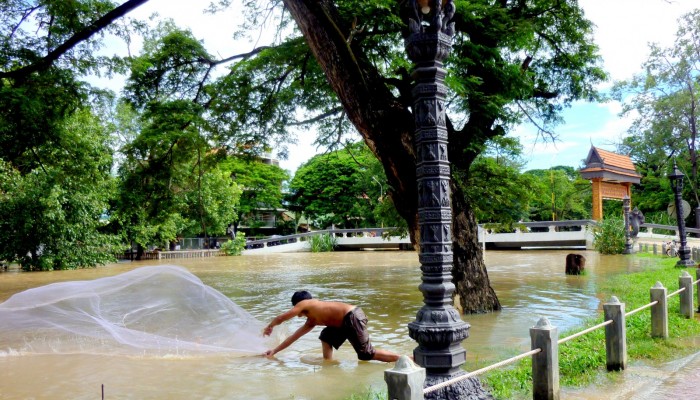Words on Wednesday aims at promoting interesting/fun/exciting publications on topics related to Energy, Resources and the Environment. If you would like to be featured on WoW, please send us a link of the paper, or your own post, at ERE.Matters@gmail.com. *** A recent Nature News Explainer by Chris Cesare describes how forecasters with the US National Oceanic and Atmospheric Administration (NOAA) ...[Read More]
Energy, Resources and the Environment
Are you READY for a flood event?
As evidenced by the EU Floods Directive (2007/60/EC), flood management strategies in Europe have undergone a shift in focus in recent years. The goal of flood prevention using structural measures has been replaced by an emphasis on the management of flood risks using non-structural measures. One implication of this is that public authorities alone not only take responsibility for flood management. ...[Read More]
Energy, Resources and the Environment
Call for sessions, General Assembly 2016
The call for sessions for the General Assembly 2016 are now open. We invite you, from now until 18 Sep 2015, to take an active part in organizing the scientific programme of the conference by suggesting new sessions or getting involved with those in the skeleton programme. In particular we would like to encourage Early Career Researchers to get involved. For more details please see here http://mee ...[Read More]
Seismology
Workshop: Software Writing Skills for Your Research
Helmholtz Centre Potsdam – GFZ German Research Centre for Geosciences, has just opened the registration for the workshop ‘Software Writing Skills for Your Research – Workshop for Novices’ planned on September 23-25, 2015. The workshop addresses the passing of software writing skills to young scientists, the next generation of researchers in the Earth, planetary and space s ...[Read More]
Energy, Resources and the Environment
Can climate data help to better predict floods?
Many studies report that hydrologic regimes are modulated by large-scale modes of climate variability such as the El Niño Southern Oscillation (ENSO) or the North Atlantic Oscillation (NAO). Climate-informed frequency analysis models have therefore been proposed to condition the distribution of hydrologic variables on climate indices. However, standard climate indices may be poor predictors in som ...[Read More]
Energy, Resources and the Environment
Words on Wednesday: River flood risk in Jakarta under scenarios of future change
Words on Wednesday aims at promoting interesting/fun/exciting publications on topics related to Energy, Resources and the Environment. If you would like to be featured on WoW, please send us a link of the paper, or your own post, at ERE.Matters@gmail.com. *** Budiyono, Y., Aerts, J. C. J. H., Tollenaar, D., and Ward, P.: River flood risk in Jakarta under scenarios of future change, Nat. Hazards Ea ...[Read More]
Energy, Resources and the Environment
Row, Row, Row Your Boat: Predicting Flood Impact with Aqueduct Global Flood Analyzer
The Aqueduct Global Flood Analyzer of the World Research Insitute is a web-based interactive platform which measures river flood impacts by urban damage, affected GDP, and affected population at the country, state, and river basin scale across the globe. It aims to raise the awareness about flood risks and climate change impacts by providing open access to global flood risk data free of charge. Th ...[Read More]
Energy, Resources and the Environment
Living with water: Floods in the Netherlands
Rising sea levels due to climate change. Natural climatic cycles, like El Niño. Land subsidence due to fluid pumping. There are many reasons that can increase the risk of flooding of cities and other areas. We might not always be able to control it, but is there a way to better predict and prepare for it? I come from the Low Lands (Netherlands), and that means we are very close to water, living on ...[Read More]
Seismology
Six Post-Doctoral Fellowships in Earth Systems (including seismology)
Six new post-doctoral fellowships have been made available at the Instituto Dom Luiz (IDL), Lisbon, Portugal. IDL, an Associate Laboratory hosted by the Faculty of Sciences, University of Lisbon, is seeking 6 highly motivated post-doctoral fellows to integrate its research groups. IDL research covers broad range Earth System Science and its applications, in areas such as Meteorology, Climatology, ...[Read More]
Energy, Resources and the Environment
Words on Wednesday: Effects of land use changes and soil conservation intervention on soil properties as indicators for land degradation under a Mediterranean climate
Words on Wednesday aims at promoting interesting/fun/exciting publications on topics related to Energy, Resources and the Environment. If you would like to be featured on WoW, please send us a link of the paper, or your own post, at ERE.Matters@gmail.com. *** Y. Mohawesh, A. Taimeh, and F. Ziadat: Effects of land use changes and soil conservation intervention on soil properties as indicators for l ...[Read More]


